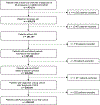Dopamine agonists and risk of lung cancer in patients with restless legs syndrome
- PMID: 36760024
- PMCID: PMC10766437
- DOI: 10.1002/pds.5596
Dopamine agonists and risk of lung cancer in patients with restless legs syndrome
Abstract
Purpose: To examine the association between long-term use of dopamine agonists (DAs) and the risk of lung cancer in patients with restless legs syndrome (RLS).
Methods: We conducted a retrospective cohort study using Optum Clinformatics® database. We included adults ≥40 years diagnosed with RLS during the study period (1/2006-12/2016). Follow-up started with the first RLS diagnosis and ended on the earliest of: incident diagnosis of lung cancer, end of enrollment in the database or end of the study period. The exposure of interest was cumulative duration of DAs use, measured in a time-varying manner. We constructed a multivariable Cox regression model to estimate HRs and 95% CIs for the association between lung cancer and cumulative durations of DA use, adjusting for potential confounding variables.
Results: We identified 295 042 patients with a diagnosis of RLS. The mean age of the cohort was 62.9; 66.6% were women and 82.3% were white. The prevalence of any DA exposure was 40.3%. Compared to the reference group (no use and ≤1 year), the crude HRs for lung cancer were 1.16 (95% CI 0.99-1.36) and 1.14 (95% CI 0.86-1.51) for 1-3 years and >3 years of cumulative DA use, respectively. The adjusted HR for lung cancer was 1.05 (95% CI 0.88-1.25) for 1-3 years and 1.02 (95% CI 0.76-1.37) for >3 years of cumulative DA use, respectively.
Conclusions: At typical doses for the clinical management of RLS, long-term DA use was not associated with risk of lung cancer.
Keywords: RLS; dopamine agonists; epidemiology; lung cancer; time-varying exposure.
© 2023 John Wiley & Sons Ltd.
Conflict of interest statement
Conflicts of Interest
The authors declare that they have no conflicts of interest.
Figures



Similar articles
-
Increased Risk for New-Onset Psychiatric Adverse Events in Patients With Newly Diagnosed Primary Restless Legs Syndrome Who Initiate Treatment With Dopamine Agonists: A Large-Scale Retrospective Claims Matched-Cohort Analysis.J Clin Sleep Med. 2019 Sep 15;15(9):1225-1232. doi: 10.5664/jcsm.7908. J Clin Sleep Med. 2019. PMID: 31538593 Free PMC article.
-
Risk of Cardiovascular Disease Associated with a Restless Legs Syndrome Diagnosis in a Retrospective Cohort Study from Kaiser Permanente Northern California.Sleep. 2015 Jul 1;38(7):1009-15. doi: 10.5665/sleep.4800. Sleep. 2015. PMID: 26083613 Free PMC article.
-
High national rates of high-dose dopamine agonist prescribing for restless legs syndrome.Sleep. 2022 Feb 14;45(2):zsab212. doi: 10.1093/sleep/zsab212. Sleep. 2022. PMID: 34417810 Free PMC article.
-
Iron for the treatment of restless legs syndrome.Cochrane Database Syst Rev. 2019 Jan 4;1(1):CD007834. doi: 10.1002/14651858.CD007834.pub3. Cochrane Database Syst Rev. 2019. PMID: 30609006 Free PMC article.
-
From bench to bedside: An overview of rotigotine for the treatment of restless legs syndrome.Clin Ther. 2014 Mar 1;36(3):436-55. doi: 10.1016/j.clinthera.2014.01.021. Clin Ther. 2014. PMID: 24636821 Review.
References
-
- Lung. International Agency for Research on Cancer. World Health Organization. https://gco.iarc.fr/today/data/factsheets/cancers/15-Lung-fact-sheet.pdf. Accessed June 21, 2021
Publication types
MeSH terms
Substances
Grants and funding
LinkOut - more resources
Full Text Sources
Medical

